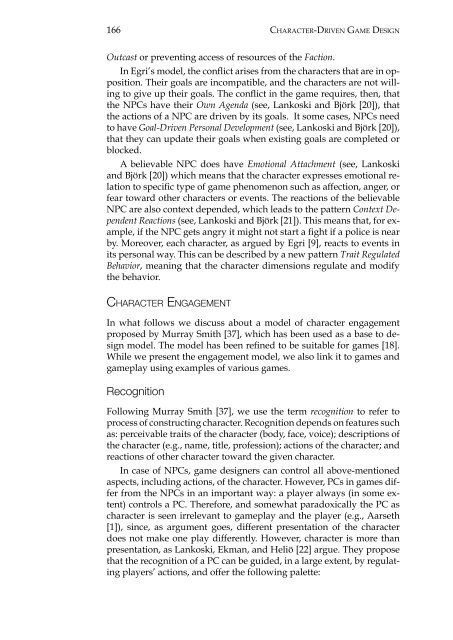Character Driven Game Design
Character Driven Game Design
Character Driven Game Design
Create successful ePaper yourself
Turn your PDF publications into a flip-book with our unique Google optimized e-Paper software.
166<br />
<strong>Character</strong>-<strong>Driven</strong> <strong>Game</strong> <strong>Design</strong><br />
Outcast or preventing access of resources of the Faction.<br />
In Egri’s model, the conflict arises from the characters that are in opposition.<br />
Their goals are incompatible, and the characters are not willing<br />
to give up their goals. The conflict in the game requires, then, that<br />
the NPCs have their Own Agenda (see, Lankoski and Björk [20]), that<br />
the actions of a NPC are driven by its goals. It some cases, NPCs need<br />
to have Goal-<strong>Driven</strong> Personal Development (see, Lankoski and Björk [20]),<br />
that they can update their goals when existing goals are completed or<br />
blocked.<br />
A believable NPC does have Emotional Attachment (see, Lankoski<br />
and Björk [20]) which means that the character expresses emotional relation<br />
to specific type of game phenomenon such as affection, anger, or<br />
fear toward other characters or events. The reactions of the believable<br />
NPC are also context depended, which leads to the pattern Context Dependent<br />
Reactions (see, Lankoski and Björk [21]). This means that, for example,<br />
if the NPC gets angry it might not start a fight if a police is near<br />
by. Moreover, each character, as argued by Egri [9], reacts to events in<br />
its personal way. This can be described by a new pattern Trait Regulated<br />
Behavior, meaning that the character dimensions regulate and modify<br />
the behavior.<br />
<strong>Character</strong> Engagement<br />
In what follows we discuss about a model of character engagement<br />
proposed by Murray Smith [37], which has been used as a base to design<br />
model. The model has been refined to be suitable for games [18].<br />
While we present the engagement model, we also link it to games and<br />
gameplay using examples of various games.<br />
Recognition<br />
Following Murray Smith [37], we use the term recognition to refer to<br />
process of constructing character. Recognition depends on features such<br />
as: perceivable traits of the character (body, face, voice); descriptions of<br />
the character (e.g., name, title, profession); actions of the character; and<br />
reactions of other character toward the given character.<br />
In case of NPCs, game designers can control all above-mentioned<br />
aspects, including actions, of the character. However, PCs in games differ<br />
from the NPCs in an important way: a player always (in some extent)<br />
controls a PC. Therefore, and somewhat paradoxically the PC as<br />
character is seen irrelevant to gameplay and the player (e.g., Aarseth<br />
[1]), since, as argument goes, different presentation of the character<br />
does not make one play differently. However, character is more than<br />
presentation, as Lankoski, Ekman, and Heliö [22] argue. They propose<br />
that the recognition of a PC can be guided, in a large extent, by regulating<br />
players’ actions, and offer the following palette:
















